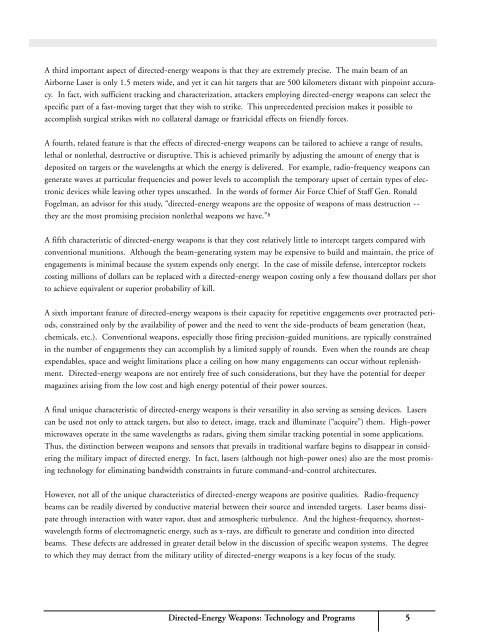directed-energy-weapons
directed-energy-weapons
directed-energy-weapons
Create successful ePaper yourself
Turn your PDF publications into a flip-book with our unique Google optimized e-Paper software.
A third important aspect of <strong>directed</strong>-<strong>energy</strong> <strong>weapons</strong> is that they are extremely precise. The main beam of anAirborne Laser is only 1.5 meters wide, and yet it can hit targets that are 500 kilometers distant with pinpoint accuracy.In fact, with sufficient tracking and characterization, attackers employing <strong>directed</strong>-<strong>energy</strong> <strong>weapons</strong> can select thespecific part of a fast-moving target that they wish to strike. This unprecedented precision makes it possible toaccomplish surgical strikes with no collateral damage or fratricidal effects on friendly forces.A fourth, related feature is that the effects of <strong>directed</strong>-<strong>energy</strong> <strong>weapons</strong> can be tailored to achieve a range of results,lethal or nonlethal, destructive or disruptive. This is achieved primarily by adjusting the amount of <strong>energy</strong> that isdeposited on targets or the wavelengths at which the <strong>energy</strong> is delivered. For example, radio-frequency <strong>weapons</strong> cangenerate waves at particular frequencies and power levels to accomplish the temporary upset of certain types of electronicdevices while leaving other types unscathed. In the words of former Air Force Chief of Staff Gen. RonaldFogelman, an advisor for this study, “<strong>directed</strong>-<strong>energy</strong> <strong>weapons</strong> are the opposite of <strong>weapons</strong> of mass destruction --they are the most promising precision nonlethal <strong>weapons</strong> we have.” 8A fifth characteristic of <strong>directed</strong>-<strong>energy</strong> <strong>weapons</strong> is that they cost relatively little to intercept targets compared withconventional munitions. Although the beam-generating system may be expensive to build and maintain, the price ofengagements is minimal because the system expends only <strong>energy</strong>. In the case of missile defense, interceptor rocketscosting millions of dollars can be replaced with a <strong>directed</strong>-<strong>energy</strong> weapon costing only a few thousand dollars per shotto achieve equivalent or superior probability of kill.A sixth important feature of <strong>directed</strong>-<strong>energy</strong> <strong>weapons</strong> is their capacity for repetitive engagements over protracted periods,constrained only by the availability of power and the need to vent the side-products of beam generation (heat,chemicals, etc.). Conventional <strong>weapons</strong>, especially those firing precision-guided munitions, are typically constrainedin the number of engagements they can accomplish by a limited supply of rounds. Even when the rounds are cheapexpendables, space and weight limitations place a ceiling on how many engagements can occur without replenishment.Directed-<strong>energy</strong> <strong>weapons</strong> are not entirely free of such considerations, but they have the potential for deepermagazines arising from the low cost and high <strong>energy</strong> potential of their power sources.A final unique characteristic of <strong>directed</strong>-<strong>energy</strong> <strong>weapons</strong> is their versatility in also serving as sensing devices. Laserscan be used not only to attack targets, but also to detect, image, track and illuminate (“acquire”) them. High-powermicrowaves operate in the same wavelengths as radars, giving them similar tracking potential in some applications.Thus, the distinction between <strong>weapons</strong> and sensors that prevails in traditional warfare begins to disappear in consideringthe military impact of <strong>directed</strong> <strong>energy</strong>. In fact, lasers (although not high-power ones) also are the most promisingtechnology for eliminating bandwidth constraints in future command-and-control architectures.However, not all of the unique characteristics of <strong>directed</strong>-<strong>energy</strong> <strong>weapons</strong> are positive qualities. Radio-frequencybeams can be readily diverted by conductive material between their source and intended targets. Laser beams dissipatethrough interaction with water vapor, dust and atmospheric turbulence. And the highest-frequency, shortestwavelengthforms of electromagnetic <strong>energy</strong>, such as x-rays, are difficult to generate and condition into <strong>directed</strong>beams. These defects are addressed in greater detail below in the discussion of specific weapon systems. The degreeto which they may detract from the military utility of <strong>directed</strong>-<strong>energy</strong> <strong>weapons</strong> is a key focus of the study.Directed-Energy Weapons: Technology and Programs5


